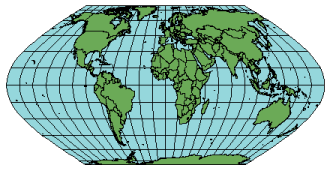Description
This equal-area projection is used primarily for world maps.

Projection method
A pseudo cylindrical equal-area projection.
Linear graticules
Parallels are unequally spaced straight lines. They are closer together at the poles. Meridians are equally spaced sinusoidal curves. The poles and the central meridian are straight lines half as long as the equator.
Properties
Shape
Shapes are stretched north–south 29 percent along the equator, relative to the east–west dimension. This stretching decreases to zero at 49°16' N and S at the central meridian. Nearer the poles, features are compressed in the north–south direction.
Area
Equivalent.
Direction
Local angles are correct at the intersection of 49°16' N and S with the central meridian. Direction is distorted elsewhere.
Distance
Scale is distorted north–south 29 percent along the equator relative to the east–west dimension. This distortion decreases to zero at 49°16' N and S at the central meridian. Scale is correct only along these parallels. Nearer the poles, features are compressed in the north–south direction.
Limitations
Useful only as a world map.
Uses and applications
Suitable for thematic mapping of the world.
Used for world distribution maps in the 1937 World Atlas by the Soviet Union.
Parameters
Desktop
- False Easting
- False Northing
- Central Meridian
Eckert VI Auxiliary Sphere (Desktop version 9.3 and later)
- False Easting
- False Northing
- Central Meridian
- Auxiliary Sphere Type
Workstation
- Longitude of Central Meridian